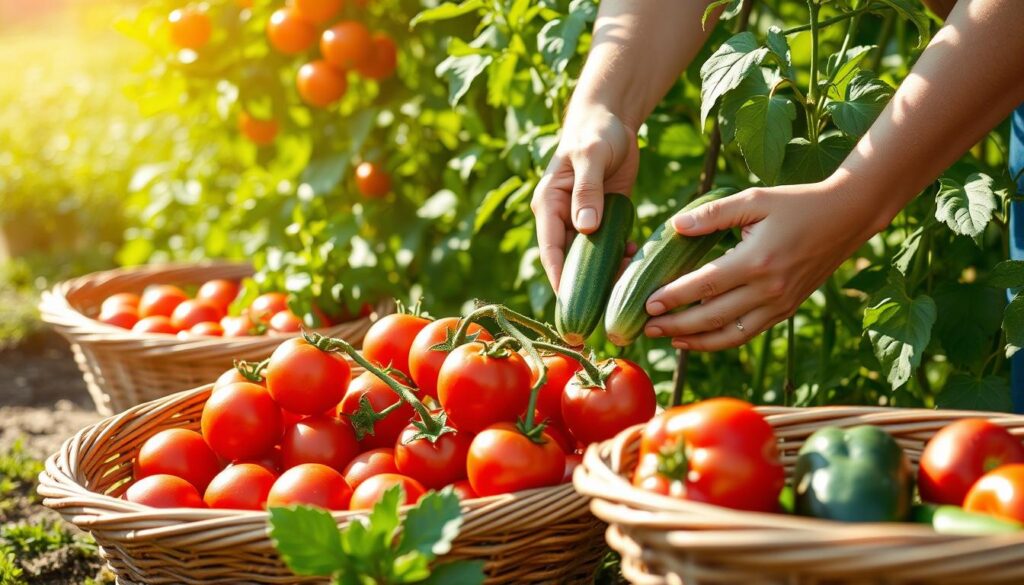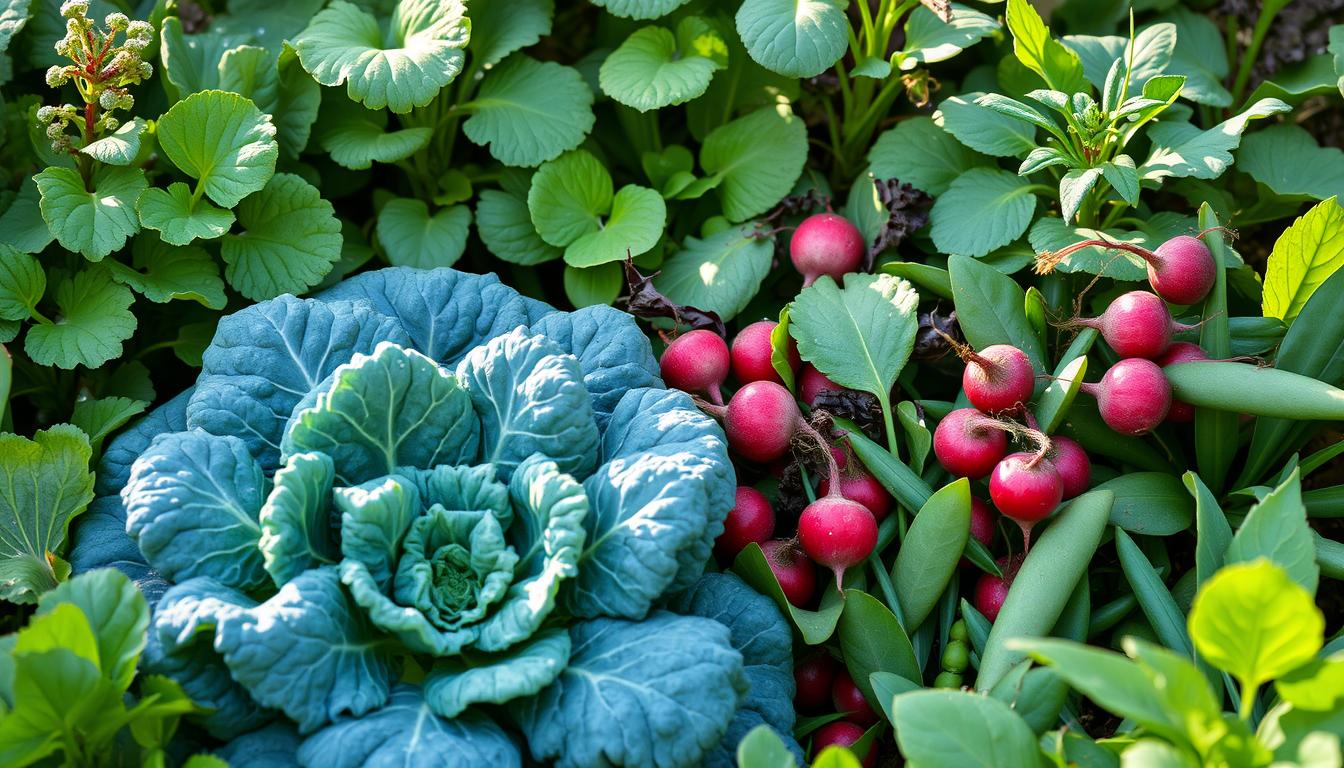I love growing my own vegetables. It’s rewarding to see my hard work turn into fresh, tasty food. This guide will help you grow your own vegetables month by month, whether you’re new or experienced.

From spring soil prep to summer harvests, I’ll cover it all. This guide is your key to a successful vegetable garden all year. You’ll learn about choosing the best plants and keeping pests away. Get ready to enjoy the best taste and health benefits of homegrown veggies!
Key Takeaways
- Comprehensive month-by-month guide to successful vegetable gardening
- Learn how to prepare the soil, sow seeds, and nurture your plants for optimal growth
- Discover techniques for harvesting and preserving your bountiful crops
- Troubleshoot common vegetable garden problems for a thriving garden
- Benefit from the unmatched flavor and nutrition of homegrown produce
Introduction to Growing Vegetables
Starting a vegetable garden can be incredibly rewarding. It lets you enjoy fresh, tasty food right from your garden. You’ll also gain many benefits that go beyond just cooking.
The Joy of Homegrown Produce
Harvesting vegetables from your garden is very fulfilling. It’s a feeling of pride and accomplishment. Imagine biting into a juicy tomato or a crisp cucumber, knowing you grew it.
Homegrown food tastes better and connects you to your meals. It’s a special way to enjoy your food.
Benefits of Growing Your Own Veggies
- Access to nutritious, pesticide-free food
- Significant cost savings compared to store-bought produce
- Reduced environmental impact by minimizing food miles and packaging
- Engaging outdoor activity that promotes physical and mental wellbeing
- The ability to experiment with a wider variety of vegetables and cultivars
Anyone can enjoy the joy and benefits of gardening, no matter the size of their space. All you need is a love for fresh, homegrown food.
“Gardening is a way of showing that you believe in tomorrow.” – Audrey Hepburn
Early Spring: Starting Your Vegetable Garden
As spring starts to show its signs, it’s time to get your vegetable garden ready. Early spring is key for a great harvest later. Start now and you’ll be rewarded in the months to come.
Preparing the Soil for Planting
Getting your soil right is crucial in early spring. Here’s what you need to do:
- Test the soil pH: Vegetables love slightly acidic soil, with a pH of 6.0 to 7.0. Use a kit to check your soil’s pH and adjust if needed.
- Amend the soil with organic matter: Add 2-3 inches of compost or well-rotted manure. This boosts soil quality and helps it hold water better.
- Ensure proper drainage: Vegetables don’t like wet soil. Make sure your garden bed drains well. Raised beds or adding sand can help.
By preparing your spring vegetable gardening soil well, you’re setting up for a successful when to start a vegetable garden season.
“The glory of gardening: hands in the dirt, head in the sun, heart with nature. To nurture a garden is to feed not just the body, but the soul.” – Alfred Austin
Late Spring: Sowing Cool-Weather Crops
As spring warms up, it’s the best time to plant cool-weather crops. Lettuce, peas, and radishes do well in the mild weather. They give you an early harvest from your garden.
For spring vegetable planting, timing is key. Plant cool-weather vegetables 4-6 weeks before the last frost. This lets them grow strong before summer heat hits.
Some cool-weather crops to plant in late spring are:
- Lettuce
- Peas
- Radishes
- Spinach
- Carrots
- Beets
To get a good early crop harvest, prepare the soil well. Add compost or manure to make it rich. These cool-weather vegetables like well-drained, slightly acidic soil with a pH of 6.0 to 7.0.
For cool-weather crops in late spring, plant them early. When the soil is cool and moist. With the right timing and care, you’ll have a lot of fresh produce soon.
Early Summer: Nurturing Your Vegetable Garden
As your vegetable plants start growing, they need the right care for a great harvest. This part will cover summer vegetable garden care. We’ll talk about watering, fertilizing, and keeping pests away with organic methods.
Watering and Fertilizing Techniques
Watering and fertilizing are key for a successful garden. Water deeply, about 1-2 inches a week, to help roots grow strong. Don’t water too often, as it can harm your plants. Use a balanced, organic fertilizer as directed.
Pest and Disease Management
Keep an eye out for pests and diseases in your garden. Use natural ways to fight them, like introducing beneficial bugs or using neem oil. Remove any sick plants quickly to stop the problem from spreading.
| Pest or Disease | Organic Control Method |
|---|---|
| Aphids | Introduce ladybugs or lacewings |
| Powdery Mildew | Apply baking soda or milk solution |
| Squash Bugs | Use a floating row cover or hand-pick eggs |
By using these methods for watering, fertilizing, and pest control, your garden will flourish. This will prepare it for a big harvest later.
A Month-by-Month Guide to Growing Vegetables
Growing a vegetable garden is rewarding and can give you fresh, healthy food all year. This monthly guide will help you through each step, from planning to harvesting and saving your crops.
Knowing when to plant is key for a good harvest. This guide is for both new and experienced gardeners. Let’s explore each month together:
January to March: Preparing for the Growing Season
In early spring, get your garden ready and start seeds indoors. Plan your garden, improve the soil, and start cool-weather crops like lettuce and spinach.
April to June: Sowing and Nurturing
When it gets warmer, plant warm-weather crops like tomatoes and cucumbers. Make sure to harden off seedlings before moving them outside. Watch out for pests and diseases too.
July to September: Harvesting and Preserving
Summer is when your garden really pays off. You’ll have lots of fresh veggies. Learn how to can and freeze to keep your harvest going.
October to December: Preparing for Winter
As it gets colder, protect your plants from frost and plan for next year. Improve your soil, rotate crops, and clean up your garden.
Follow this guide to grow a successful vegetable garden. Happy planting!
| Month | Vegetable Planting Suggestions |
|---|---|
| January | Start seeds indoors for cool-weather crops like lettuce, spinach, and radishes. |
| April | Sow warm-weather crops like tomatoes, peppers, and cucumbers outdoors. |
| July | Harvest and preserve your summer bounty through canning and freezing. |
| October | Prepare your garden beds for the winter by amending the soil and cleaning up. |
“Gardening is not just a hobby, but a way of life that connects us to the natural world and the cycles of the seasons.”
Mid-Summer: Harvesting and Preserving
Summer is in full swing, and your garden is overflowing with fresh veggies. It’s time to enjoy the fruits of your labor and save some for later. We’ll look at the best ways to harvest vegetables and explore food preservation techniques. We’ll focus on canning and freezing vegetables.
Canning and Freezing Methods
Canning and freezing are top choices for saving your garden’s bounty. Each method has its own benefits, depending on the veggie and your taste.
Canning keeps veggies fresh and tasty for a long time. You seal them in jars or cans to stop spoilage and keep nutrients. It’s great for veggies like tomatoes, peppers, and green beans.
Freezing is quick and easy for saving your harvest. It quickly cools veggies, preserving their taste and freshness. It’s good for many veggies, from greens to roots.
| Canning | Freezing |
|---|---|
| Suitable for high-moisture vegetables | Suitable for a wide range of vegetables |
| Requires specialized equipment and processing | Easier setup and storage |
| Provides long-term shelf life (up to 1 year) | Provides medium-term shelf life (up to 12 months) |
| Retains more nutrients compared to freezing | Retains good flavor and texture |
Choose your preservation method wisely to keep your vegetable harvesting fresh. With the right food preservation techniques, you can enjoy summer’s taste all year.

Late Summer: Planting Fall Crops
As summer ends, it’s time to start planning for our fall garden. We can enjoy a rich harvest in autumn by planting cool-weather crops in late summer. It’s important to plant at the right time to help our veggies grow well in the cooler weather.
Cool-Weather Vegetables for Autumn
Here are some top cool-weather veggies to plant in late summer for a great autumn harvest:
- Broccoli – Plant broccoli seedlings in late summer for a fall crop that can withstand the first frost.
- Kale – This nutrient-dense green grows well in the cooler fall weather and can even be harvested into the winter.
- Carrots – Sow carrot seeds in late summer for a crisp, sweet autumn harvest.
- Radishes – Quick-growing radishes can be planted in late summer for a speedy fall crop.
- Spinach – Plant spinach seeds in late summer for a delicious fall harvest of this nutrient-rich green.
When planning your fall vegetable gardening, make sure to check the best planting times for autumn harvest. This depends on your local climate. But usually, you should sow cool-weather crops like these in late summer, about 4-6 weeks before your first frost.
By planning and planting your cool-weather vegetables in late summer, you can look forward to a bountiful autumn harvest from your garden.
Autumn: Preparing for Winter
As autumn arrives with its cool breeze, it’s time to get your garden ready for winter. This includes protecting plants from frost and using smart overwintering methods. These steps are key to a successful garden next year.
Protecting Plants from Frost
Keeping your vegetables safe from frost is a top priority in autumn. Here are some effective ways to do it:
- Cover tender plants with row covers, cold frames, or cloches to shield them from cold.
- Mulch around plants with straw, leaves, or organic material to keep roots warm.
- Use frost blankets or greenhouses for extra warmth on sensitive crops.
These steps help your plants survive the cold nights and get ready for winter.
Overwintering Techniques
Autumn is also the best time to start overwintering strategies. This means:
- Move cool-weather crops like kale and Brussels sprouts to a safe spot or cold frame.
- Compost and enrich your soil with organic matter to boost its health for spring.
- Remove dead or sick plants to stop pests and diseases from spreading.
By preparing your garden well in autumn, you’ll enjoy a rich harvest next year.
“Autumn is a second spring when every leaf is a flower.” – Albert Camus
Winter: Planning for Next Year’s Garden
When winter comes, many gardeners think their work is over. But winter is the best time to plan for next year’s garden. Focus on crop rotation and soil improvements to get ready for a great vegetable garden.
Crop Rotation: Balancing Nutrients and Deterring Pests
Crop rotation keeps your garden healthy and productive. By changing the crops in each bed, you avoid nutrient loss. This also keeps pests and diseases away from your plants.
To plan a good crop rotation, list the vegetable families you want to grow. These include nightshades, legumes, and brassicas. Then, create a schedule to rotate these families through your garden beds each year.
Soil Amendments: Replenishing Nutrients and Improving Structure
Improving your soil is crucial in winter garden planning. Soil nutrients can get used up over time. Add organic matter like compost to make your soil better for plants.
Soil tests can show what nutrients are missing. Use specific amendments like bone meal or greensand to fix these issues. By improving your soil now, you’ll have a better garden next year.
Vegetable gardening is a year-round job. Planning ahead with crop rotation and soil amendments prepares your garden for success. Even in winter, your garden can thrive.
Troubleshooting Common Vegetable Garden Problems
As a devoted vegetable gardener, I’ve faced many challenges. Pests and diseases can be frustrating, but they can be managed. I’ll share how to tackle these issues with organic methods.
Tackling Pests and Diseases
Common garden pests and diseases are a big problem. Aphids, slugs, and fungal infections are just a few examples. To fight these, I use organic pest control strategies.
- Introducing beneficial insects like ladybugs and lacewings to naturally control pests
- Using natural repellents like garlic, onions, or neem oil to deter unwanted visitors
- Regularly inspecting your plants and removing any affected leaves or stems to prevent the spread of diseases
Being proactive helps keep your garden healthy. This way, you can avoid harsh chemicals.
Addressing Nutrient Deficiencies
Nutrient deficiencies can cause stunted growth and poor yields. To fix this, I test my soil and add organic matter. This includes compost or well-rotted manure.
Remember, vegetable garden troubleshooting is about being observant and adaptable. By using organic methods, you can enjoy a bountiful harvest.
Conclusion
As we wrap up this guide on growing vegetables all year, let’s review the main points. Growing your own food brings many benefits. You get fresh, tasty meals and the happiness of gardening.
By following the advice in this guide, you can create a thriving garden. You’ll learn how to prepare the soil in spring and protect plants in autumn. This ensures a good harvest every season.
Whether you’re experienced or new to gardening, the perks of growing your own veggies are huge. You’ll enjoy the best taste and health benefits of homegrown food. Plus, you’ll feel proud of being self-sufficient and helping the environment. I hope this guide has motivated you to start gardening and enjoy its many benefits.



Leave a Reply